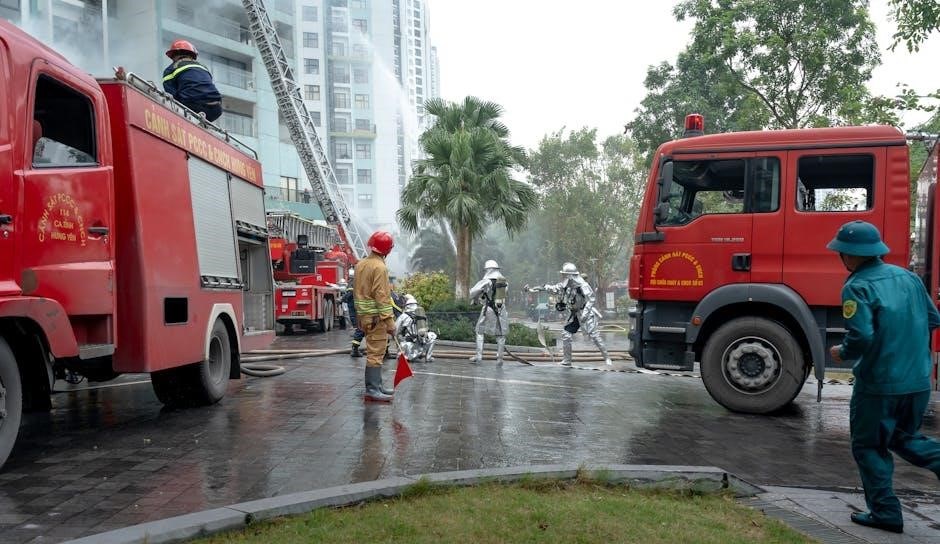EI Smoke Alarms are advanced detection devices designed to provide early warnings of potential fires‚ ensuring home safety and peace of mind.

1.1 Importance of Smoke Alarms in Home Safety
Smoke alarms are crucial for early fire detection‚ reducing the risk of injury‚ death‚ and property damage. They detect visible smoke from smoldering fires‚ providing vital seconds for escape. EI Smoke Alarms are designed to alert occupants promptly‚ ensuring safety and compliance with fire safety regulations. Their effectiveness is proven to minimize fire-related fatalities. Key features include advanced sensors‚ loud alerts‚ and compliance with local standards‚ making them essential for every home.
1.2 Key Features of EI Smoke Alarms
EI Smoke Alarms feature cutting-edge optical sensing technology for accurate smoke detection‚ reducing false alarms. They offer interlinking capabilities‚ allowing multiple alarms to sound simultaneously for enhanced safety. The Hush Button enables quick silencing of false alarms without disconnecting the device. These alarms are designed with tamper-proof battery compartments and rechargeable battery options‚ ensuring continuous protection. With compliance to fire safety standards‚ EI Smoke Alarms provide reliable performance and peace of mind. Additional features include low-battery alerts and smart home integration options‚ making them versatile and user-friendly for modern homes.

Installation and Setup
Proper installation ensures your EI Smoke Alarm functions effectively. Follow the guide to choose optimal locations and set up your alarm securely for reliable protection.
2.1 Choosing the Right Location for Your Smoke Alarm
Proper placement is crucial for effective fire detection. Install smoke alarms on every level of your home and inside sleeping areas. Opt for central locations‚ such as hallways or landings‚ to ensure optimal coverage. Avoid areas near kitchens or bathrooms to minimize false alarms caused by cooking fumes or steam. Keep alarms at least 10 feet away from cooking appliances and avoid drafty spots like windows or fans. Ensure no obstacles block the sensor’s view. This strategic placement ensures your EI Smoke Alarm provides reliable protection and early warning in case of a fire.
2.2 Step-by-Step Installation Guide
Begin by unpacking your EI Smoke Alarm and ensuring all components are included. Locate the ideal spot‚ avoiding areas near kitchens or bathrooms. Drill holes for the mounting plate‚ securing it firmly to the wall or ceiling. Attach the alarm to the plate‚ ensuring a snug fit. For wired models‚ connect the wires to the terminal block‚ following the manufacturer’s wiring diagram. Insert the battery for battery-powered alarms‚ using a 9V alkaline type. Test the alarm by pressing the test button until it sounds. Finally‚ secure the alarm cover and ensure it is level. Refer to the manual for specific wiring instructions if necessary.
2.4 Hardwiring vs. Battery-Powered Options
Choosing between hardwiring and battery-powered EI Smoke Alarms depends on your needs. Hardwired alarms are more reliable with a consistent power supply and often include a battery backup for outages. They are ideal for whole-home systems and can be interconnected for enhanced safety. Installation may require professional help. Battery-powered alarms offer ease of installation and flexibility‚ perfect for renters or DIY setups. They depend on regular battery replacements‚ which can be inconvenient but ensure functionality without wiring. Consider maintenance‚ cost‚ and local regulations when deciding which option suits your home best.

Understanding Alarm Indicators and Controls
EI Smoke Alarms use light and sound indicators to signal alerts or errors. The Hush Button silences false alarms‚ while error messages guide troubleshooting. These features ensure safety and ease of use.
3.1 Light and Sound Indicators: What They Mean
EI Smoke Alarms use visual and auditory signals to communicate their status. A steady green light indicates normal operation‚ while a flashing red light signals smoke detection. Beeping sounds alert users to potential fires or errors. Continuous beeps indicate an active alarm‚ while intermittent chirps may signal low battery or system issues. Understanding these indicators is crucial for responding appropriately to emergencies or maintenance needs. Always consult the user manual for detailed explanations of specific light and sound combinations to ensure proper interpretation and action. These features enhance safety and user confidence in the alarm system’s reliability. Regular checks are recommended to verify indicator functionality.
3.2 Hush Button: Managing False Alarms
The Hush Button on EI Smoke Alarms allows users to temporarily silence false alarms caused by cooking smoke or steam. Pressing this button ensures the alarm stops beeping without disabling its detection capabilities. It is located on the front of the device for easy access. The Hush feature is designed to provide convenience while maintaining safety‚ as the alarm will automatically resume monitoring after a short period. Regularly investigating the cause of false alarms is essential to prevent recurring issues. This feature enhances user experience by minimizing unnecessary disruptions while ensuring reliable fire detection. Always refer to the user guide for proper usage instructions.

Maintenance and Testing
Regular maintenance ensures optimal performance. Clean the alarm with a soft brush or vacuum to remove dust. Test monthly to confirm proper function and sensitivity.
4.1 Cleaning and Dust Removal Tips
Regular cleaning is essential for maintaining your EI Smoke Alarm’s performance. Use a soft‚ dry brush or vacuum cleaner to gently remove dust and debris from the exterior and interior. Avoid using chemicals‚ water‚ or abrasive materials‚ as they may damage the sensor. For stubborn dust‚ a compressed air duster can be used cautiously. Clean the alarm at least once a month‚ or more frequently in dusty environments. Ensure the alarm is turned off before cleaning to prevent accidental activation. Regular maintenance ensures your device remains sensitive to smoke and functions reliably during emergencies.
4.2 Battery Replacement and Care
Replace the battery in your EI Smoke Alarm every 12 months or when the low-battery warning sounds. Use only 9V alkaline batteries‚ such as Duracell or Energizer‚ for optimal performance. Avoid using rechargeable or mixed batteries‚ as they may cause malfunctions. To replace‚ turn off the alarm‚ remove the old battery‚ and insert the new one with the terminals facing the correct direction. Check the battery’s expiration date before installation. Never disable or tamper with the battery compartment‚ as this can compromise safety. Properly dispose of old batteries following local regulations. Test the alarm after replacement to ensure it’s functioning correctly.
4.3 Regular Testing Procedures
Test your EI Smoke Alarm monthly by pressing and holding the test button until the alarm sounds. This ensures the sensor‚ battery‚ and sounder are functioning correctly. Additionally‚ perform a weekly visual inspection to check for dust or debris. Once a year‚ replace the battery and clean the alarm using a soft brush or vacuum cleaner. For interlinked systems‚ test all units simultaneously to confirm they activate together. Regular testing helps maintain reliability and ensures your safety in case of an emergency. Always follow the manufacturer’s guidelines for testing and maintenance to keep your smoke alarm in optimal condition.

Troubleshooting Common Issues
Identify and resolve issues like false alarms or error codes by checking the user manual. Reset the alarm if it malfunctions‚ ensuring proper operation and safety.
5.1 Resolving False Alarms
False alarms often occur due to cooking smoke or steam. Press the Hush Button to temporarily silence the alarm. Ensure the alarm is clean and free from dust. Replace batteries annually. For persistent issues‚ check for obstructions or improper installation. Refer to the user manual for troubleshooting steps. Regular testing and maintenance can prevent false alarms‚ ensuring the device operates correctly during real emergencies. Always use recommended batteries and follow manufacturer guidelines for optimal performance.
5.2 Error Messages and Solutions
Identify error messages on your EI smoke alarm by referring to the user manual. Common issues include low battery alerts or sensor malfunctions. A steady red light or continuous beeps may indicate a problem. Check for dust or debris obstructing the sensor and clean it gently. If the alarm chirps intermittently‚ replace the battery with a recommended 9V alkaline type. For persistent errors‚ reset the alarm by removing the battery for 30 seconds. Ensure proper installation and wiring to avoid false triggers. Regular testing and maintenance can prevent many issues‚ ensuring reliable performance and home safety.

5.3 Resetting Your Smoke Alarm
To reset your EI smoke alarm‚ first remove the battery and wait 30 seconds. Reinstall the battery‚ ensuring it’s securely connected. For hardwired models‚ switch off the mains power for 15 minutes before resetting. Clean the sensor with a soft brush or vacuum to remove dust. Press and hold the test button until the alarm sounds‚ confirming the reset. If issues persist‚ refer to the user manual for specific instructions. Regular resets and maintenance ensure optimal performance and reliable fire detection‚ keeping your home and family safe.

User Safety and Best Practices
Ensure your EI smoke alarm is tested weekly‚ cleaned monthly‚ and batteries replaced annually. Avoid improper power sources and follow all manual instructions for optimal safety and performance.
6.1 What to Do When the Alarm Sounds
Stay calm and prioritize safety. Immediately evacuate the premises‚ ensuring all occupants exit safely. Do not investigate the source of the alarm. Call the fire brigade or emergency services if not already contacted. If the alarm is due to a false trigger‚ press the Hush Button to silence it temporarily. Never disable the alarm permanently. After ensuring safety‚ check for potential causes and resolve them. Always follow your emergency evacuation plan and avoid re-entering the building until it is confirmed safe by authorities. Regularly practice drills to ensure preparedness in case of an actual emergency.
6.2 Preventing False Alarms: Tips and Tricks
To minimize false alarms‚ ensure your EI Smoke Alarm is installed away from kitchens‚ bathrooms‚ and areas prone to steam or cooking fumes. Regularly clean the unit to remove dust and debris‚ which can trigger unnecessary alerts. Avoid placing alarms near open windows or doors where drafts may carry smoke-like particles. Use the Hush Button to temporarily silence false alarms. Replace batteries as recommended to maintain reliability. Test your alarm weekly to ensure it’s functioning correctly without causing unnecessary scares. By following these tips‚ you can reduce false alarms and rely on your smoke alarm for true emergencies.
6.3 Staying Safe During an Emergency
When your EI Smoke Alarm sounds‚ stay calm and act quickly. Ensure all household members are aware of the alarm and know the escape plan. Exit the premises immediately through the nearest safe route‚ closing doors behind you to contain potential fires. Do not hide or return for belongings. Assemble at a designated safe meeting point outside the building. If smoke is present‚ stay low to avoid inhaling toxic fumes. Do not re-enter the building until authorities confirm it is safe. Use the Hush Button only to silence false alarms‚ not during a real emergency. Always prioritize your safety and the safety of others.

Additional Features and Compatibility
EI Smoke Alarms offer advanced features like interlinking capabilities‚ smart home integration‚ and compatibility with various safety systems‚ enhancing overall home protection and convenience.
7.1 Interlinking Multiple Smoke Alarms
Interlinking EI Smoke Alarms ensures a unified response to fire detection. When one alarm detects smoke‚ all interconnected units activate‚ providing comprehensive coverage throughout your home. This feature enhances safety by alerting occupants in every area‚ even if the fire is confined to one room. Hardwired systems typically use wiring to connect alarms‚ while wireless models rely on radio frequencies. Interlinking is especially crucial in larger homes or multi-story buildings‚ ensuring no one is left unaware of a potential threat. Always follow the manufacturer’s instructions for proper installation and setup to maintain reliability and effectiveness.
7.2 Smart Home Integration Options
EI Smoke Alarms can seamlessly integrate with smart home systems‚ enhancing convenience and safety. Compatible with popular platforms like Zigbee and Z-Wave‚ these alarms can connect to smart hubs‚ enabling voice control via Amazon Alexa or Google Assistant. Users can receive real-time notifications on their smartphones through dedicated apps‚ ensuring awareness even when away from home. Remote capabilities allow silencing alarms or checking statuses‚ reducing false alarm disruptions. For setup‚ follow the user manual’s specific instructions to ensure proper integration. Regular software updates are essential to maintain compatibility and functionality‚ ensuring your smart home remains secure and efficient.

Regulatory Compliance and Warranty
EI Smoke Alarms comply with local fire safety regulations and come with a comprehensive warranty‚ ensuring reliability and protecting your investment in home safety devices.
8.1 Meeting Local Fire Safety Regulations
EI Smoke Alarms are designed to meet local fire safety regulations‚ ensuring compliance with standards like BS 5839-6:2019 for residential properties. They are CE-certified‚ guaranteeing adherence to European safety norms. Hardwired models and interlinking capabilities align with building codes‚ providing reliable fire detection. Regular testing and maintenance‚ as outlined in user guides‚ help maintain compliance. Always verify with local authorities to ensure installation meets specific requirements. Proper setup and adherence to guidelines ensure your smoke alarms function as intended‚ offering peace of mind and legal compliance.
8.2 Understanding Your Warranty Coverage
EI Smoke Alarms come with a comprehensive warranty‚ typically covering manufacturing defects for a period of 5 years. The warranty ensures that any faulty components are repaired or replaced free of charge‚ provided the alarm is installed and maintained correctly. Proper registration and adherence to user guidelines are essential for warranty validation. For detailed terms‚ refer to the product’s user manual or contact Ei Electronics support. The warranty does not cover damage caused by improper installation or misuse. Always retain your purchase receipt and installation records for warranty claims.